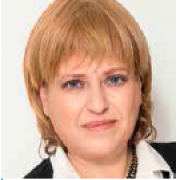Senior Lecturer, Department of Pathology, Sackler Faculty of Medicine
Co-editor, Diabetes/Metabolism Research and Reviews
D-Cure Scientific Committee

Senior Lecturer, Department of Pathology, Sackler Faculty of Medicine
Co-editor, Diabetes/Metabolism Research and Reviews
D-Cure Scientific Committee
Dr. Wertheimer is a leading researcher in the field of diabetes, insulin and insulin receptors, wound healing and skin pathology. She received her M.D from Tel Aviv University and her Ph.D from the Dept. of Endocrinology and Metabolism at Hebrew University, Hadassah Medical Center in Jerusalem.
She has received several prestigious awards and grants, including the Wolfson fellowship award, the American Physician Fellowship - Kass Fund Award for Medical Research, JDRF career development award, and ISF, ICRF, IDDT, JDRF, D-CURE and DKFZ research grants, and is an author over 50 scientific publications and book chapters in peer review journals.
Role of the Insulin Receptor in Skin and Implications to Diabetes
The insulin receptor (IR) is one of the best-studied tyrosine kinase receptors. The receptor transmits insulin actions, and functions in the metabolic regulation of glucose in insulin sensitive tissues – muscle, liver and adipose tissue. In recent years, however, additional roles have emerged for the IR in various tissues including the regulation of transcription and translation, cell proliferation, differentiation and more.
Our research interests center on the role of insulin and the IR in skin. The importance of insulin and the IR in skin is evident when insulin action is impaired in insulin resistance and diabetes: One of the major known insulin resistance- and diabetes-associated skin complications is the impaired wound healing leading to amputations, increased illness and high mortality rates. Another skin complication associated with insulin resistance and diabetes is the marked increase in the risk, aggression, and recurrence of non-melanoma skin cancer. leading to the development of the diabetes-associated skin pathologies.
We have identified a previously unknown unique signaling pathway in which insulin via the IR regulates the assembly of the cellular cytoskeleton in skin cells. As can be seen in the figure attached below, IR inactivation, mimicking insulin resistance, led to a striking abnormality in the structure and assembly of cytoskeleton filaments in the skin epithelial cells.
Such an abnormality in cytoskeleton assembly can explain the observed changes in cellular division, proliferation and migration of IR null skin cells. Furthermore, since these processes are involved in wound healing from one hand as well as in tumorigenesis on the other hand, the disassembled cytoskeleton could be part of the pathogenesis.
In order to prove the importance of insulin and the IR in skin, and more specifically to wound healing and to skin tumorigenesis, we generated a skin-specific IR null mouse. In this mouse, the IR is inactivated only in the skin epidermis, without the development of hyperglycemia or other biochemical changes. By studying this mouse, we demonstrated that lack of epidermal IR by itself led to severely impaired wound healing. Furthermore, in another set of studies we demonstrated that IR inactivation in skin led to a marked decrease in transformation of skin cells in vitro as well as in skin tumorigenesis in vivo. Moreover, IR inhibition led to the reversal of transformation of transformed skin cells.
Our results indicate that the skin itself is abnormal in diabetes as a result of impaired insulin signaling, and that it should become an independent target for treatment and prevention of diabetes-associated skin pathologies. This research will lead to new means to reverse and prevent diabetes-associated skin complications from developing, effectively treat them, and halt their progression.
Solomon Zemler R, Weingarten G, Sarfstein R, Laron Z, Werner H, Wertheimer E. Insulin analogues display atypical differentiative activities in skin keratinocytes. Arch Physiol Biochem. 2015; 121:32-9.
Falik Zaccai TC, Kalfon L, Klar A, Elisha MB, Hurvitz H, Weingarten G, Chechik E, Fleisher Sheffer V, Haj Yahya R, Meidan G, Gross-Kieselstein E, Bauman D, Hershkovitz S, Yaron Y, Orr-Urtreger A, Wertheimer E. Two novel mutations identified in familial cases with Donohue syndrome. Mol Genet Genomic Med. 2014; 2:64-72.
Sarfstein R, Pasmanik-Chor M, Yeheskel A, Edry L, Shomron N, Warman N, Wertheimer E, Maor S, Shochat L, Werner H. Insulin-like growth factor-I receptor (IGF-IR) translocates to nucleus and autoregulates IGF-IR gene expression in breast cancer cells. J Biol Chem. 2012; 287:2766-76.
Maor G, Vasiliver-Shamis G, Hazan-Brill R, Wertheimer E, Karnieli E. GLUT4 in murine bone growth: from uptake and translocation to proliferation and differentiation. Am J Physiol Endocrinol Metab. 2011; 300:E613-23.
Patent